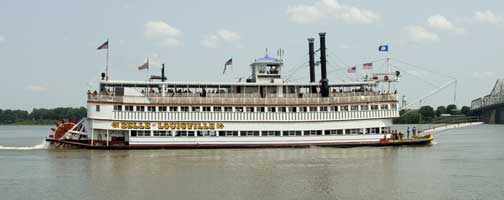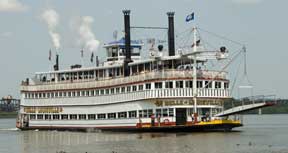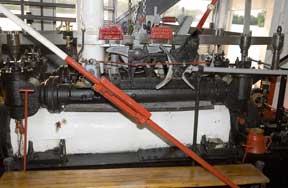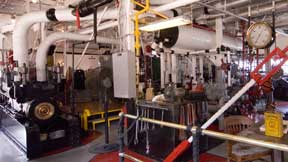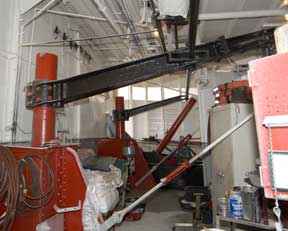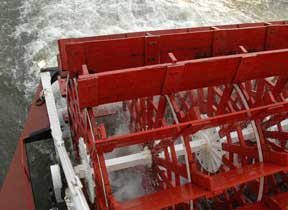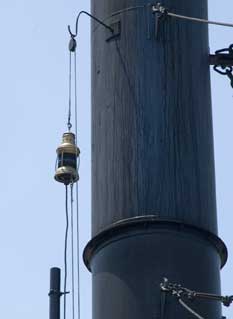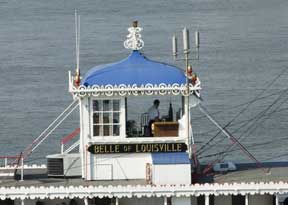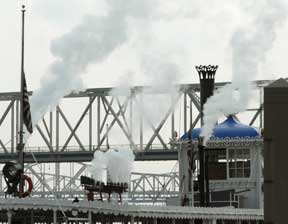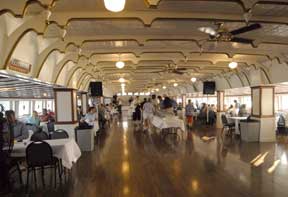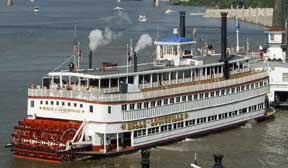River boat origins
Sternwheelers were used in many parts of the world but the North American designs were unique. Some vessels took on a distinctive west coast design but the hull and engine design originated in the western river system (Mississippi). Most of the early western river boats were sidewheelers. Sternwheel boats were developed as circumstances changed. The basic idea, a very light shallow draft hull with powerful engines, was the same on either type of vessel
Versions of these boats were used on rivers and lakes all over North America and many other parts of the world. The size and construction varied somewhat as to builder, location, trade and owner. Many factors changed the way the boats were constructed. On the western rivers the early boats became very ornate floating palaces to attract passengers. Speed was important. As the railroad encroached on the passenger trade freight became more important. The American Civil War devastated the river trade for some years.
The western rivers' boats with lever type high pressure engines and flue boilers were used in many parts of the world including California, Canadian prairies and parts of the Yukon. The west coast type boat, originated on the lower Columbia, with large slide valve HP engines and railroad boilers could be found in British Columbia, parts of the Yukon, Northern Alberta and on the Mackenzie River system.
The start of the steam era on the Mississippi
Settlers started arriving in the Ohio valley in the late 18th century. Before that French fur traders had traded with the Indians. The roads were, at best, trails. The settlers started floating rafts loaded with goods down to New Orleans.
In 1810 most of the Mississippi was uninhabited. The need to access the center of a vast continent pushed the development of a reliable form of transportation. Several steam boats were tried on the Ohio without much success. The first boats on the river were patterned after sailing ships. While builders knew a flat bottomed vessel would be ideal they did not know how to keep this type of hull from twisting and falling apart. The engines used were often the heavy low pressure type that had proved themselves on the bays and inlets further north.
The shallow waters and strong currents soon showed these vessels to be impractical. The development of a vessel suited to fresh water operation became a necessity.
Three things were needed to make these boats viable.
1. Shallow draft hull with light housework.
2. Light high pressure engine.
3. Boilers that could supply the high pressure steam.
The evolution of the hulls started with getting rid of the keels and making the bottom totally flat. The super structure was built up over a very low hull. A high pressure horizontal engine was also developed for this type of vessel. The first of these engines did not resemble the horizontal engine found on most of the later boats. Soon the engines and boilers were brought up to the main deck. The boilers were a unique high pressure flue type. The development of lighter wider hulls took years of experimentation.
Construction
The first boats were small. But, by the middle of the 19th century there were some that were as long as 350 ft. but most of them were in the 240 to 270 ft. range. The early boats did not look anything like the western rivers’ steamboats we see in photographs. While we are used to the pilot house being located in the center of the vessel aft of the stacks many of the early boats had the pilot house well forward. Most of the boats were sidewheelers.
The light construction and long hulls produced a weak girder form. To overcome this longitudinal bulkheads along with hog posts and chains or iron-rods were used. Continual experiments with samson posts and cross chains supporting the heavy side wheels were tried. It wasn’t until this system of hog chains was perfected that the sternwheel could be used on larger vessels. As a rule sidewheelers needed less strengthening due to the weights being more centralized than stern wheel boats. Keelsons running the length of the vessel were used to strengthen the hull. It soon became apparent that solid keelsons were too heavy. Eventually most keelsons were made up of braced timbers.
The shallow hulls could not carry much cargo so a big house was built over the main deck. to house the cargo, boilers and machinery. This main deck house was heightened and wide guards placed along the sides of the vessel to the outer edge of the paddle wheels. Housework was added on the upper deck, or boiler deck for passengers. These accommodations became quite lavish. On many boats mens’ section was aft and the ladies’ section was forward. The early rooms were named after the states of the union and this is where the term stateroom came from. The deck above these cabins was called the hurricane deck. When another deck was added it was called the texas deck. The pilot house was placed on the texas deck. The names of the decks changed somewhat depending on the year and location but the texas deck was usually the topmost deck that the pilot house was located on. The vessels had two chimneys (stacks) placed side by side well forward so the pilot could see between them.
The sidewheel packet boats had large guards or sponsons to protect the paddle boxes. The stern wheelers often did not have these sponsons.
These vessels did not have a long life span. A lot of them had accidents and the construction methods produced a weak hull. In the 1850s they had a life of four or five years.
After the Civil War several types of steam riverboats evolved. Most of the larger boats were side wheelers. These sternwheelers and smaller boats were known as “local traders.” or “short traders” or “mountain boats” . With the exception of the Belle of Louisville most of these boats are gone now.
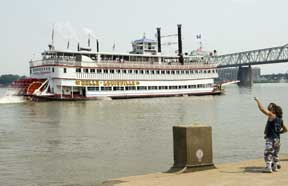
|

